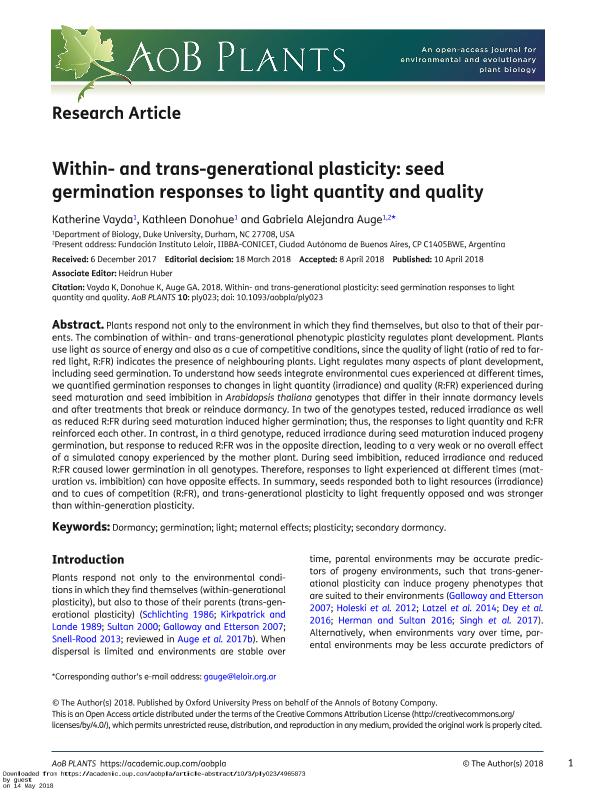Mostrar el registro sencillo del ítem
dc.contributor.author
Vayda, Katherine
dc.contributor.author
Donohue, Kathleen
dc.contributor.author
Auge, Gabriela Alejandra

dc.date.available
2019-11-01T19:23:46Z
dc.date.issued
2018-05
dc.identifier.citation
Vayda, Katherine; Donohue, Kathleen; Auge, Gabriela Alejandra; Within- and trans-generational plasticity: Seed germination responses to light quantity and quality; Oxford University Press; AoB PLANTS; 10; 3; 5-2018; 1-17
dc.identifier.issn
2041-2851
dc.identifier.uri
http://hdl.handle.net/11336/87851
dc.description.abstract
Plants respond not only to the environment in which they find themselves, but also to that of their parents. The combination of within- and trans-generational phenotypic plasticity regulates plant development. Plants use light as source of energy and also as a cue of competitive conditions, since the quality of light (ratio of red to farred light, R:FR) indicates the presence of neighbouring plants. Light regulates many aspects of plant development, including seed germination. To understand how seeds integrate environmental cues experienced at different times, we quantified germination responses to changes in light quantity (irradiance) and quality (R:FR) experienced during seed maturation and seed imbibition in Arabidopsis thaliana genotypes that differ in their innate dormancy levels and after treatments that break or reinduce dormancy. In two of the genotypes tested, reduced irradiance as well as reduced R:FR during seed maturation induced higher germination; thus, the responses to light quantity and R:FR reinforced each other. In contrast, in a third genotype, reduced irradiance during seed maturation induced progeny germination, but response to reduced R:FR was in the opposite direction, leading to a very weak or no overall effect of a simulated canopy experienced by the mother plant. During seed imbibition, reduced irradiance and reduced R:FR caused lower germination in all genotypes. Therefore, responses to light experienced at different times (maturation vs. imbibition) can have opposite effects. In summary, seeds responded both to light resources (irradiance) and to cues of competition (R:FR), and trans-generational plasticity to light frequently opposed and was stronger than within-generation plasticity.
dc.format
application/pdf
dc.language.iso
eng
dc.publisher
Oxford University Press

dc.rights
info:eu-repo/semantics/openAccess
dc.rights.uri
https://creativecommons.org/licenses/by-nc-sa/2.5/ar/
dc.subject
DORMANCY
dc.subject
GERMINATION
dc.subject
LIGHT
dc.subject
MATERNAL EFFECTS
dc.subject
PLASTICITY
dc.subject
SECONDARY DORMANCY
dc.subject.classification
Ciencias de las Plantas, Botánica

dc.subject.classification
Ciencias Biológicas

dc.subject.classification
CIENCIAS NATURALES Y EXACTAS

dc.title
Within- and trans-generational plasticity: Seed germination responses to light quantity and quality
dc.type
info:eu-repo/semantics/article
dc.type
info:ar-repo/semantics/artículo
dc.type
info:eu-repo/semantics/publishedVersion
dc.date.updated
2019-10-22T17:54:11Z
dc.journal.volume
10
dc.journal.number
3
dc.journal.pagination
1-17
dc.journal.pais
Reino Unido

dc.journal.ciudad
Oxford
dc.description.fil
Fil: Vayda, Katherine. University of Duke; Estados Unidos
dc.description.fil
Fil: Donohue, Kathleen. University of Duke; Estados Unidos
dc.description.fil
Fil: Auge, Gabriela Alejandra. Consejo Nacional de Investigaciones Científicas y Técnicas. Oficina de Coordinación Administrativa Parque Centenario. Instituto de Investigaciones Bioquímicas de Buenos Aires. Fundación Instituto Leloir. Instituto de Investigaciones Bioquímicas de Buenos Aires; Argentina. University of Duke; Estados Unidos
dc.journal.title
AoB PLANTS
dc.relation.alternativeid
info:eu-repo/semantics/altIdentifier/doi/http://dx.doi.org/10.1093/aobpla/ply023
dc.relation.alternativeid
info:eu-repo/semantics/altIdentifier/url/https://academic.oup.com/aobpla/article/10/3/ply023/4965873
Archivos asociados
